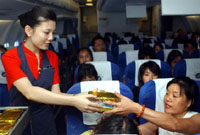
China Southern Airlines, one of the country's largest airways, will launch regular flights between the central city of Changsha and Seoul starting October, a company executive said Wednesday.
The new service will offer five return flights a week on Mondays, Wednesdays, Thursdays, Fridays and Sundays between Changsha, capital of central China's Hunan Province and Seoul of the Republic of Korea, said Xu Xiaolin, director of the market office of the Hunan branch of China Southern.
China Southern plans to use Airbus 320 plane for the fights, with the flight number CZ3065/6.
The flights will depart from Changsha at 11 a.m. (Beijing time) and arrive in Seoul at 2:35 (Seoul time) p.m. The return flights will depart from Seoul at 3:35 p.m. and arrive in Changsha at 5:35 p.m., Xu said.
Prior to the new regular flights, Xu said, only chartered flights were available between Changsha and Seoul. They were operated by two Chinese airlines, the China Southern Airlines and the China Eastern Airlines, and two ROK airways - Korean Air and Asiana Airlines.
Under the chartered flight system, the airways worked with travel agencies and the air tickets could only be sold by contractors in the ROK, Xu said.
"The chartered flight service is for tourist groups, but not suitable for individual business people," she said. "The new service will be more convenient for people in Hunan and the ROK."
Hunan has seen a surge of ROK tourists to Zhangjiajie, a well-known scenic spot in the province, in recent years. The number of ROK tourists to Zhangjiajie city grew from 100,000 in 2002 to nearly 500,000 last year, statistics with the Hunan provincial tourism administration show.
The first chartered flights between Seoul and Changsha were launched in Nov. 2005.
Currently, there are no direct flights between Seoul and Zhangjiajie as the latter does not have international airport status, Xu said.
But China Southern will add return flights from Changsha to Zhangjiajie to enable passengers to travel around the three cities on the same plane, she said.
(Xinhua News Agency September 14, 2006)
|

